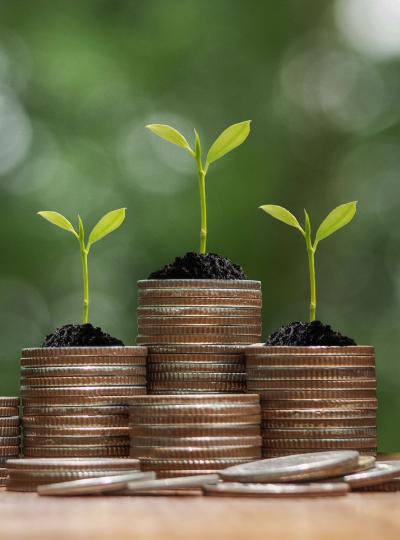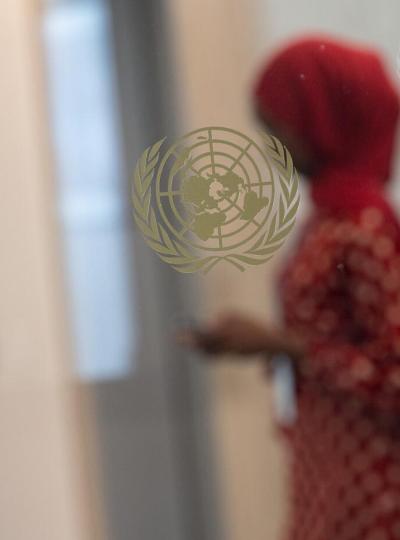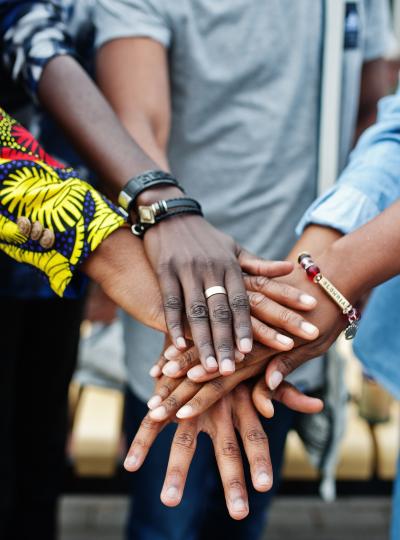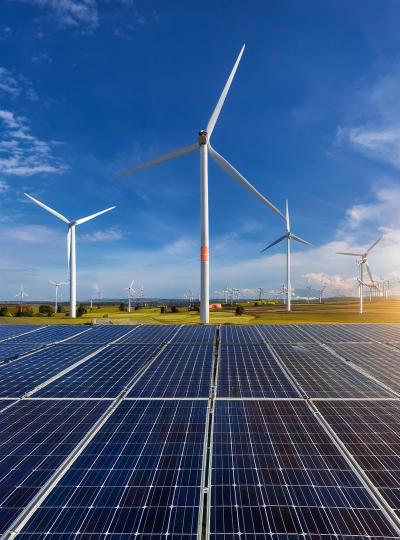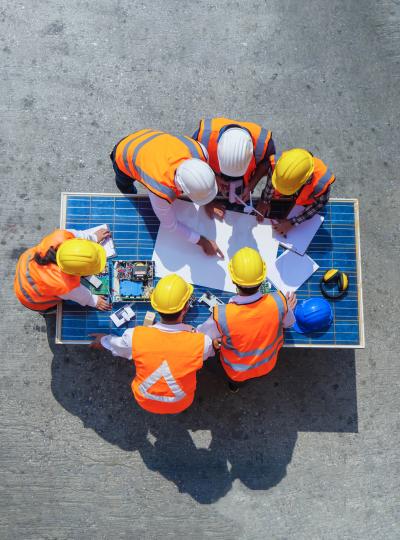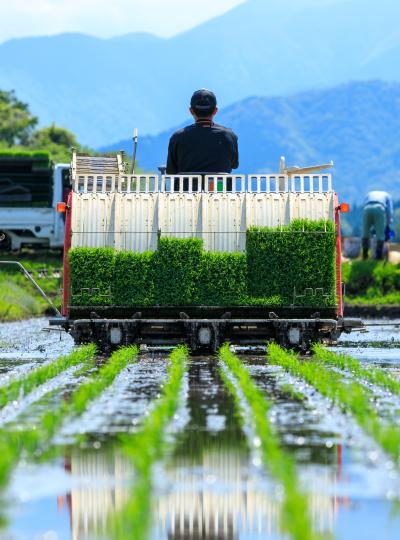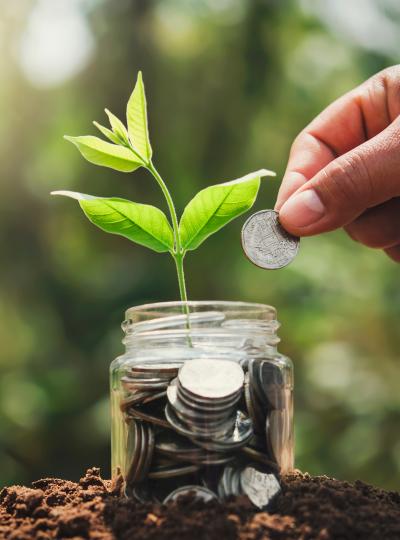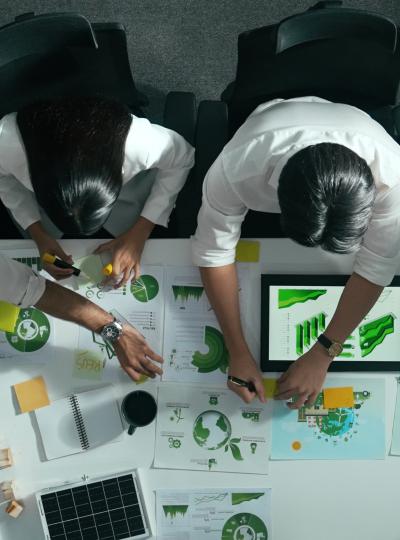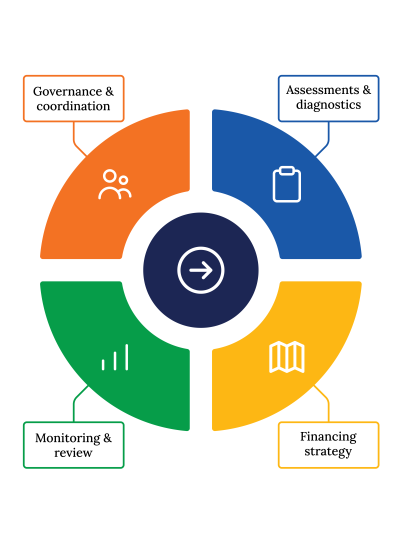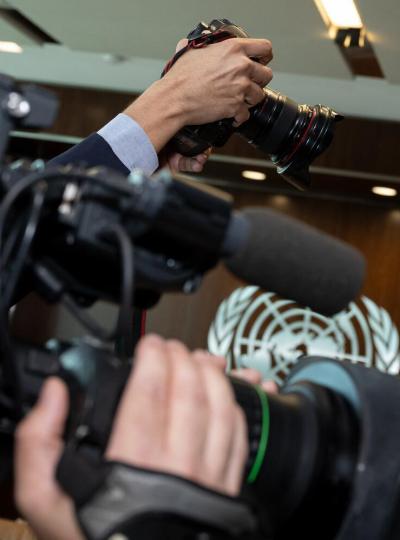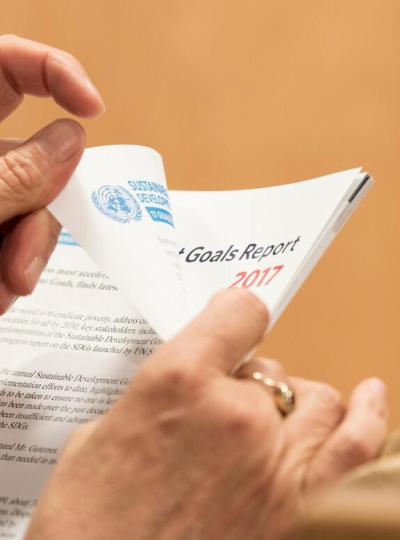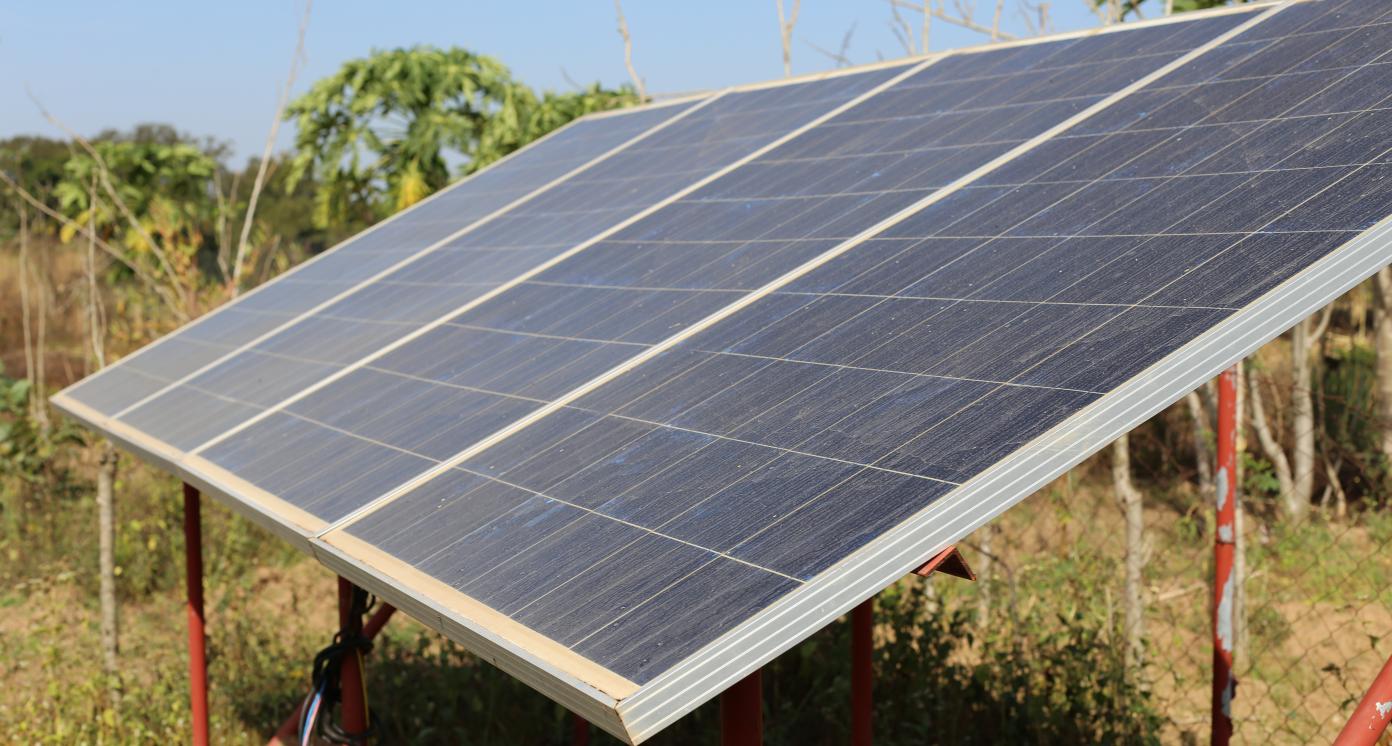Off-Grid Solar PV Systems for Agricultural Use
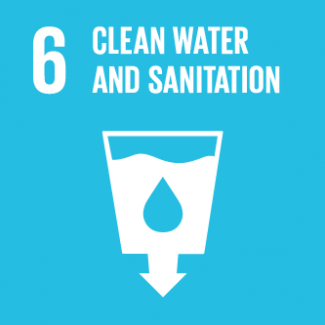
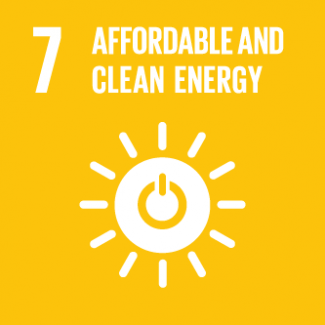
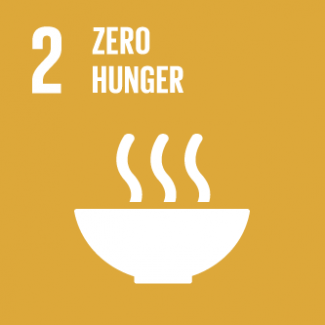
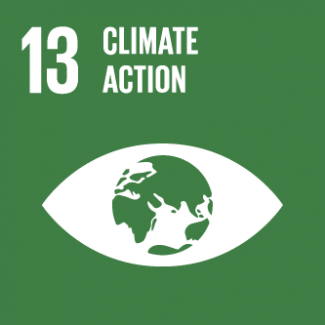

Business Model Description
Provide villages and SMEs with photovoltaic (PV) solar-powered products such as water pumps and pump controllers to extend water supply and improve food refrigeration. A Pay-As-You-Go framework can be implemented to allow low-income households to purchase solar products in affordable, incremental payments. Sector-specific products can be offered, including ice machines for fishermen, refrigerators for milk producers and farmers, and for markets. Installation and maintenance services can also be provided as an additional offer.
Expected Impact
Expand electricity access and contribute to improved health through better sanitation and food refrigeration.
How is this information gathered?
Investment opportunities with potential to contribute to sustainable development are based on country-level SDG Investor Maps.
Disclaimer
UNDP, the Private Finance for the SDGs, and their affiliates (collectively “UNDP”) do not seek or solicit investment for programmes, projects, or opportunities described on this site (collectively “Programmes”) or any other Programmes, and nothing on this page should constitute a solicitation for investment. The actors listed on this site are not partners of UNDP, and their inclusion should not be construed as an endorsement or recommendation by UNDP for any relationship or investment.
The descriptions on this page are provided for informational purposes only. Only companies and enterprises that appear under the case study tab have been validated and vetted through UNDP programmes such as the Growth Stage Impact Ventures (GSIV), Business Call to Action (BCtA), or through other UN agencies. Even then, under no circumstances should their appearance on this website be construed as an endorsement for any relationship or investment. UNDP assumes no liability for investment losses directly or indirectly resulting from recommendations made, implied, or inferred by its research. Likewise, UNDP assumes no claim to investment gains directly or indirectly resulting from trading profits, investment management, or advisory fees obtained by following investment recommendations made, implied, or inferred by its research.
Investment involves risk, and all investments should be made with the supervision of a professional investment manager or advisor. The materials on the website are not an offer to sell or a solicitation of an offer to buy any investment, security, or commodity, nor shall any security be offered or sold to any person, in any jurisdiction in which such offer would be unlawful under the securities laws of such jurisdiction.
Country & Regions
- Côte d'Ivoire: Savanes
- Côte d'Ivoire: Zanzan
- Côte d'Ivoire: Vallée du Bandama
- Côte d'Ivoire: Montagnes
Sector Classification
Renewable Resources and Alternative Energy
Development need
Although renewables constitute a more inclusive energy source amid rising national demand and a prevalent energy poverty, production depends mainly on fossil fuels (69% of total). Increases in energy production enabled to triple the share of the population with access to electricity (95%) but the share of renewable energy in the mix, notably hydroelectric, has decreased between 2010 and 2023 (1, 2, 17).
Policy priority
Under the National Renewable Energy Action Plan 2014–2030 the government targets 42% of renewables in the mix by 2030, revised to 45%. It also aims to expand production capacity to 4,000 MW by 2025 and 5,000 MW by 2030. In its NDCs, Côte d'Ivoire pledged to increase electricity production from renewables. Expanding access to energy and renewables is also a central theme of the National Development Plan (Pillar 3) and is a crucial element of Côte d'Ivoire's goal of becoming an upper-middle income country, as set out in its Vision 2030 (3, 4, 5, 17, 18).
Gender inequalities and marginalization issues
While access to electricity has improved, it remains limited in northern areas. Some households in grid-connected settlements do not have access to electricity, and affordability remains a pressing concern. Energy poverty concerns 91% of the rural population (6).
Investment opportunities introduction
Africa's 3rd largest electricity network, Côte d'Ivoire can attract USD 9 billion investments in renewable energy by 2030. Biomass potential equals 16.7 million tons/year from cacao, palm oil, coffee, etc. while solar potential exceeds 1,900 kWh/m². This favors investments at utility scale but also for mini-grid and hybrid applications (7, 9).
Key bottlenecks introduction
Renewable projects are exposed to climatic events such as storms, high winds, floods and landslides which could damage production plants and electricity poles. They also require prior authorization from the Ministry of Energy to ensure alignment with national energy efficiency and sustainability goals, which may involve a lengthy process (9, 19).
Alternative Energy
Development need
90% of the forests have vanished in 60 years, reducing agricultural productivity. Despite grid connection, high costs hamper electricity access, forcing reliance on fuels. Moreover, the country struggles with droughts, uneven water access (67% rural), and poor food market hygiene, exacerbating health risks. Biowaste recycling and green energies could mitigate these issues (4, 11, 12).
Policy priority
The programs "Electricité pour Tous" and "Accès à l'eau potable en milieu rural" aim for universal access to electricity and drinking water by 2025 and 2030, notably through solar-powered water pumps. These include financial inclusion and the installation of 1,200 water infrastructures. The nation plans to increase solar energy production, targeting an 7-9% share in its energy mix, supported by IFC's Scaling Solar program (8, 9, 14).
Gender inequalities and marginalization issues
In Côte d'Ivoire's northern regions, 87% of households use wood for energy due to high electricity costs, intensifying deforestation despite government subsidies for methane gas, which still pollutes significantly. Additionally, water access is closely linked to income, with informal city settlements and remote villages facing severe shortages, worsening their economic and health challenges (10, 12).
Investment opportunities introduction
Côte d'Ivoire supports investment in infrastructure to achieve universal water access by 2030 with a USD 5 billion pledge. The government also supports renewable energy projects such as the Aboisso biomass plant. Additionally, with financial backing from IFC and AfDB, developments such as the USD 400 million Azito power station have been launched (9, 14).
Key bottlenecks introduction
Poor road network maintenance may hamper biomass production, as traffic interruptions can halt operations. Additionally, dust accumulation and storms reduce solar plant productivity. Moreover, local residents may struggle to maintain and replace outdated water pumps, compounded by limited access to finance, especially in villages lacking government support (8, 13, 16).
Solar Technology and Project Developers
Pipeline Opportunity
Off-Grid Solar PV Systems for Agricultural Use
Provide villages and SMEs with photovoltaic (PV) solar-powered products such as water pumps and pump controllers to extend water supply and improve food refrigeration. A Pay-As-You-Go framework can be implemented to allow low-income households to purchase solar products in affordable, incremental payments. Sector-specific products can be offered, including ice machines for fishermen, refrigerators for milk producers and farmers, and for markets. Installation and maintenance services can also be provided as an additional offer.
Business Case
Market Size and Environment
10% - 15%
In Cote d’Ivoire, applications of solar power to agriculture and productive uses such as solar pumping have a high potential due to the fact that about 50% of households without access to electricity own around 70% of the agricultural land. Investments could tap into a continent-scale expansion potential of CAGR of 11.70% between 2024 and 2030 (44, 46).
Indicative Return
10% - 15%
A benchmark study in Côte d’Ivoire showcases a company that provides decentralized solar systems for productive use such as solar pumps through last mile distribution of pay as you go products and is expected to generate an IRR of 13% in 3.8 years for a USD 2 million investment (39).
Investment Timeframe
Short Term (0–5 years)
A benchmark study in Côte d’Ivoire showcases a company that provides decentralized solar systems for productive use such as solar pumps through last mile distribution of pay as you go products and is expected to generate an IRR of 13% in 3.8 years for a USD 2 million investment (39).
Ticket Size
USD 1 million - USD 10 million
Market Risks & Scale Obstacles
Market - High Level of Competition
Capital - Limited Investor Interest
Business - Supply Chain Constraints
Impact Case
Sustainable Development Need
13% of the population did not have access to clean water in 2023 while the percentage of households who did not have access to drinking water in less than 30 minutes amounted to 22% in 2021. This constitutes a threat to public health, affecting particularly the elderly (17, 46).
In 2020, 10.8% of the rural population experienced food insecurity. Simultaneously, at the national level, food waste accounts for a third of all waste produced, and 30 to 60 of agricultural production is lost, partly due to improper food storage and cooling (17, 47, 48).
Water access faces challenges especially in regions with limited electricity or high diesel costs (17).
Gender & Marginalisation
Women are disproportionately responsible for collecting water and managing household sanitation, a direct consequence of the lack of water pumps in rural areas (20).
In southern regions, saltwater intrusion into coastal aquifers could worsen due to sea level rise, resulting in negative consequences for water supply as well as food supply (fish, agriculture) (21).
Expected Development Outcome
Solar-powered water pumps and distribution systems enhance access to clean water, while solar-powered refrigeration improves food safety and security, both significantly improving public health.
Solar PV solutions for water pumping and cooling in Côte d'Ivoire can help stabilize food production and reduce crop loss by ensuring reliable irrigation and extending food shelf life through solar-powered refrigeration.
Solar-powered water pumps for irrigation provides reliable water access without relying on grid electricity or diesel. This reduces CO2 emissions, lowers operational costs, and increases crop yields, benefiting farmers, especially in remote areas, by enhancing food security and economic resilience.
Gender & Marginalisation
Water pumps can help isolated villages accessing clean water and improving sanitation. They can also alleviate the burden of water carrying for women.
Solar PV solutions for water pumping and cooling can mitigate the impacts of saltwater intrusion by providing coastal communities with alternative, clean water supplies for both drinking and irrigation. Additionally, solar-powered refrigeration can support fish and crop preservation, helping to stabilize food resources.
Primary SDGs addressed

6.1.1 Proportion of population using safely managed drinking water services
6.2.1 Proportion of population using (a) safely managed sanitation services and (b) a hand-washing facility with soap and water
The proportion of population using safely managed drinking water services was 81% in 2023 (17).
In 2022, the proportion of population using safely managed sanitation services was 17% overall (24).
N/A
The long-term objective for this indicator is 100% (27).

7.1.2 Proportion of population with primary reliance on clean fuels and technology
The proportion of population with primary reliance on clean fuels and technology was 42.6% in 2022, and 7.4% in rural areas (53).
The government aims to multiply by five the number of households using biogas or solar energy and liquefied natural gas for cooking purposes by 2030, from 6.3 million in 2016 to 33.1 million in 2030 (3).

2.1.1 Prevalence of undernourishment
2.1.2 Prevalence of moderate or severe food insecurity in the population, based on the Food Insecurity Experience Scale (FIES)
13.6% of children below 5 were undernourished in Côte d'Ivoire in 2021 (50).
In 2020, 10.8% of the rural population experienced food insecurity (17).
The long-term objective for this indicator is 0% (51).
The objective for this indicator is to end food insecurity by 2030 (52).
Secondary SDGs addressed


Directly impacted stakeholders
People
Gender inequality and/or marginalization
Planet
Corporates
Public sector
Indirectly impacted stakeholders
People
Gender inequality and/or marginalization
Planet
Outcome Risks
If Côte d'Ivoire does not have the adequate infrastructure to manage obsolete solar panels, it faces the challenges of soil pollution and unlawful dumping of toxic waste.
Solar-powered systems have lower energy expenses compared to diesel ones, which could lead to water overuse due to lower extraction costs (38).
If the price of photovoltaic solutions is too high, they could be acquired only by the most affluent farmers, exacerbating economic inequalities.
Impact Risks
If solar panels are not frequently maintained, the result is lower productivity and long-term deterioration of the panels, which can become toxic waste if not recycled.
If spare parts for the solar equipment are not readily available, the systems could fail or degrade in performance, reducing the long-term benefits.
If photovoltaic systems for water pumping or cooling are more expensive than diesel alternatives, there is a risk that, without public support, their market will remain limited.
Solar-powered systems are vulnerable to theft. If an insurance mechanism is not implemented, farmers may be reluctant to adopt this technology (38).
If the sale of solar equipment mainly concerns the highly fertile regions of the South, due to high transport costs or logistical difficulties, the impact on territorial inequalities would be limited.
Impact Classification
What
Providing off-grid solar PV systems for agricultural use would benefit populations, farmers and traders, improving public health and nutrition.
Who
Remote villages would benefit from improved water access and food refrigeration, particularly children and women, alleviating the burden of water pumping and transportation.
Risk
Without regular maintenance, spare parts, and insurance, solar systems face reduced performance, potential waste, limited adoption, and heightened inequality, particularly in marginalized regions.
Contribution
Refrigeration, water supply, and pump systems replace less efficient mechanical methods, as well as polluting processes (such as fuel oil). In the case of refrigeration, they can help expand its use in areas where it is not commonly practice
How Much
The Ivorian government targets universal access to electricity by 2025. In addition, it plans to equip 1,000 villages with solar-powered pumps by 2026, aiming to ensure access to sufficient and quality drinking water for over 4,000,000 people (17, 59).
Impact Thesis
Expand electricity access and contribute to improved health through better sanitation and food refrigeration.
Enabling Environment
Policy Environment
The National Renewable Energy Action Plan 2014–2030 (Plan d’action national des énergies renouvelables 2014-2030 or PANER) outlines key objectives to improve access to clean energy, notably through the distribution of solar photovoltaic kits and the installation of mini solar plants, and the development of pumping and irrigation using renewable energies (3).
The National Energy Efficiency Action Plan (Plan d’Action National d’Efficacité Énergétique or PANEE) targets improvements in energy efficiency across various sectors from 2016 to 2030. This plan aims to reduce energy losses and promote the use of solar-powered solutions by households, such as solar cookers and cooling devices to replace more polluting alternatives (charcoal, wood) (33).
The Rural Electrification Plan (Plan Directeur d'Electrification Rurale or PDER) prioritizes grid extension over off-grid strategies (targeting 2% of the population relying on standalone systems by 2030), but only concerns villages of over 500 inhabitants (30).
Financial Environment
Fiscal incentives: The Investment Code provides fiscal incentives for investments in renewable energies, including exemption from various commercial and profit taxes. It also offers an exemption from patents and licenses contribution and an 80% to 90% reduction of employers' contribution (33).
Fiscal incentives: The new Investment Code sets a discounted VAT rate of 9% on solar equipment (33).
Other incentives: In 2021, the World Bank approved a USD 22.5 million funding for the Regional Off-Grid Electricity Access Project (ROGEAP). It aims to expand the market for off-grid solar systems in West Africa, supporting regional market development and the entrepreneurial ecosystem to improve solar access in underserved areas (45).
Regulatory Environment
Decree No. 2016-787 of October 12, 2016 outlines the regulations applicable to the production, distribution, and commercialization of electricity produced by mini-networks or autonomous individual systems (35).
Order No. 105 of 13 December 2019 exempts self-production of energy from authorization and declaration if the power is below 500 W. For systems between 0.5 kW and 20 kW, self-production is permitted, but a prior declaration is required. Installations exceeding 20 kW require formal prior authorization (40).
Order No. 104 of 13 December 2019 outlines the penalties applicable to concessionnaires engaged in generation, distribution, and retailing of electricity through mini-grids and/or standalone systems violating performance indicators (37).
The Power Africa Off-grid Project (PAOP), funded by USAID, provides technical assistance and grant funding to expand off-grid solar energy solutions across sub-Saharan Africa. Focusing on policy support, market intelligence, business performance, and financing, PAOP aims to increase energy access through private sector involvement, particularly for solar home systems (SHS) and mini-grids (55).
Marketplace Participants
Private Sector
AD Solar, Aphelion Energy, PEG Africa, Phaesun, EDF Energy, Orange Energy, Scheider Electric, Apinome, Yandalux, Alternative Energy, Betrad, SI2E, ENR, Ohel International, Optima, Lifi-LED, Baobab+, Confédération Générale des Entreprises de Côte d’Ivoire (CGECI).
Government
Ministère de l'hydraulique, Office national de l’eau potable, Ministère du Pétrole, de l'Énergie et des Énergies Renouvelables (MPEER), Autorité Nationale de Régulation du Secteur de l'Électricité (ANARE-CI), CI-Energies, Société de Distribution d'Eau de Côte d'Ivoire, Centre de Promotion des Investissements en Côte d’Ivoire (CEPICI).
Multilaterals
European Investment Bank, International Finance Corporation (IFC), African Development Bank (AfDB), World Bank, European Union (EU).
Non-Profit
Water and Sanitation for All, U.S. Agency for International Development (USAID), Fondation Energies pour le Monde (Fondem), Practical Action, WaterAid, Netherlands Development Organisation.
Target Locations
Côte d'Ivoire: Savanes
Côte d'Ivoire: Zanzan
Côte d'Ivoire: Vallée du Bandama
Côte d'Ivoire: Montagnes
References
- (1) Connaissance des Energies. 2020. Côte d'Ivoire : la principale centrale électrique va être agrandie pour augmenter la production nationale de 10%. https://www.connaissancedesenergies.org/afp/cote-divoire-la-principale-centrale-electrique-va-etre-agrandie-pour-augmenter-la-production-nationale-de-10-200309
- (2) Banque Mondiale. 2020. The secret to cote d'ivoire's electric success. https://www.banquemondiale.org/fr/news/feature/2020/07/23/the-secret-to-cote-divoires-electric-success
- (3) Gouvernement de Côte d'Ivoire. 2016. Plan d'Actions National pour les Energies Renouvelables. https://www.se4all-africa.org/fileadmin/uploads/se4all/Documents/Country_PANER/CO%CC%82TE_D%E2%80%99IVOIRE_Plan_d_Actions_National_pour_les_Energies_Renouvelables.pdf
- (4) Gouvernement de la Côte d'Ivoire. 2022. Contributions Déterminées au niveau National (CDN) de la Côte d'Ivoire. https://unfccc.int/sites/default/files/NDC/2022-06/CDN_CIV_2022.pdf
- (5) Gouvernement de la Côte d'Ivoire. 2021. Plan national de développement PND 2021-2025. https://www.gouv.ci/doc/1646220586PND-2021-2025-UNE-COTE-D-IVOIRE-SOLIDAIRE-RESUME-SYNTHETIQUE.pdf
- (6) Arouna Diallo. 2020. Analyse économique de la pauvreté énergétique. Le cas de la Côte d’Ivoire. https://theses.hal.science/tel-04019370/document
- (7) Jeune Afrique. 2023. Comment la Côte d'Ivoire navigue entre électricité pour tous et ambitions vertes. https://www.jeuneafrique.com/1411441/economie-entreprises/comment-la-cote-divoire-navigue-entre-electricite-pour-tous-et-ambitions-vertes/
- (8) AfDB. 2022. Cote d’Ivoire - projet électricité pour tous – Rapport d’évaluation de projet. https://www.afdb.org/fr/documents/cote-divoire-projet-electricite-pour-tous-rapport-devaluation-de-projet
- (9) IFC. 2018. IFC and Government of Côte d’Ivoire Release Roadmap Towards 2030 Renewable Energy Targets. https://documents1.worldbank.org/curated/en/566921532638485663/pdf/128912-WP-ENGLISH-IVC-Unlocking-private-investment-PUBLIC.pdf
- (10) Sanitation and Water for All. 2019. Côte d'Ivoire Country Brief. https://www.sanitationandwaterforall.org/sites/default/files/migrate_default_content_files/Cote_dlvoire_Country_Brief.pdf
- (11) Afrik 21. 2021. Côte d'Ivoire 90% du couvert forestier a diparu en 60 ans. https://www.afrik21.africa/cote-divoire-90-du-couvert-forestier-a-disparu-en-60-ans/
- (12) Josué, D. et al. 2021. Les inégalités spatiales dans la desserte en eau potable et accès aux logements dans la ville de Divo (sud-Ouest de la Côte d'Ivoire). https://www.researchgate.net/publication/356158628_Les_inegalites_spatiales_dans_la_desserte_en_eau_potable_et_acces_aux_logements_dans_la_ville_de_Divo_sud-ouest_de_la_Cote_d%27ivoire
- (13) Diallo, A. 2022. Analyse économique de la pauvreté énergétique. Le cas de la Côte d’Ivoire. https://theses.hal.science/tel-04019370/document
- (14) Programme social du gouvernement. 2022. Renforcement du programme d'accès à l'eau potable en milieu rural. https://psgouv.ci/v2/welcome/details_sous_menu/renforcement-du-programme-d-accs-l-eau-potable-en-milieu-rural184
- (15) Maillard, T. et al. 2019. Accès à l'eau potable dans les villages de la région de Gbêké. https://shs.hal.science/halshs-02277173/document
- (16) Isaacs, S. et al. 2023. Dust soiling effects on decentralized solar in West Africa. https://www.sciencedirect.com/science/article/abs/pii/S0306261923003574
- (17) Ministère de l'Economie, du Plan et du Développement. 2023. Plan National de Développement 2021-2025. Rapport Annuel 2023. RAPPORT ANNUEL 2023
- (18) Présidence de la République de Côte d'Ivoire. 2020. Résumé du Plan Stratégique - Côte d’Ivoire 2030. https://www.google.com/url?sa=t&rct=j&q=&esrc=s&source=web&cd=&ved=2ahUKEwi4nKu5xYOJAxUqe6QEHT0YCakQFnoECBMQAQ&url=https%3A%2F%2Fdocuments.economie-ivoirienne.ci%2Findex.php%3Fp%3Dfstream-pdf%26fid%3D12%26bid%3D10&usg=AOvVaw2p-ZhmUDLoHni8ydslpsBZ&opi=89978449
- (20) Sanitation and Water for All. 2024. Eau, assainissement et hygiène. https://www.sanitationandwaterforall.org/fr/a-propos/eau-assainissement-et-hygiene/genre
- (21) FMI. 2023. Rapport du FMI No 23/204 Côte d'Ivoire - Annexe V. Défis liés aux changements climatiques. https://www.google.com/url?sa=t&rct=j&q=&esrc=s&source=web&cd=&cad=rja&uact=8&ved=2ahUKEwjWtfeh0PWDAxVEQvEDHbSqCjYQFnoECA4QAQ&url=https%3A%2F%2Fwww.imf.org%2F-%2Fmedia%2FFiles%2FPublications%2FCR%2F2023%2FFrench%2F1CIVFA2023001.ashx&usg=AOvVaw1nRNbYUmY_ba9hPEJ_8jPy&opi=89978449
- (22) Financial Afrik. 2020. Eau potable : la Côte d'Ivorie veut relever le taux d'accès. https://www.financialafrik.com/2020/02/14/eau-potable-la-cote-divoire-veut-relever-le-taux-dacces/
- (23) UNDP. 2022. Rapport sur la situation des ODD, prenant en compte les personnes vulnérables et le genre en Côte d'Ivoire - 2017-2022. https://www.undp.org/fr/cote-d-ivoire/publications/rapport-sur-la-situation-des-odd-prenant-en-compte-les-personnes-vulnerables-et-le-genre-en-cote-divoire-2017-2020
- (24) World Bank. 2024. People using safely managed sanitation services (% of population) - Cote d'Ivoire. https://donnees.banquemondiale.org/indicateur/SH.STA.SMSS.ZS?locations=CI
- (25) Solar quarter. 2021. Vergnet Hydro to Implement Hybrid Solar Water Pumps in Ivory Coast. https://solarquarter.com/2021/12/15/vergnet-hydro-to-implement-hybrid-solar-water-pumps-in-ivory-coast/
- (26) UNEP. 2024. Interactive country fiches - Côte d'Ivoire. https://dicf.unepgrid.ch/cote-divoire/water#section-impacts
- (27) SDG Transformation Center. 2024. Sustainable Development Report. https://dashboards.sdgindex.org/map/indicators/population-using-at-least-basic-sanitation-services
- (28) Ministère de l'Energie. 2022. Programme national d'électrification rurale et program d'électricité pour tous : le premier ministre Patrick Achi rappelle les acquis. https://www.gouv.ci/_actualite-article.php?recordID=13183
- (29) Gouvernement de Côte d'Ivoire. 2022. Projet "eau pour tous" : 105 000 branchements sociaux a abidjan, 9 chateaux d’eau et 40 unites de production d’eau potable prefabriquees mis en service a l’interieur du pays. https://www.gouv.ci/_actualite-article.php?recordID=13020
- (30) CI-Energies. Electrification rurale. https://www.cinergies.ci/electrification-rurale/
- (31) Inbo-news. Programme for the rehabilitation and conversion of 1,000 water points with hybrid pumps and management systems. https://www.inbo-news.org/sites/default/files/content/incubation/8114-en-program-rehabilitation-and-conversion-1000-water-points-hybrid-pumps-and-management-systems.pdf?d=154605
- (32) APB Energy. 2024. Energie solaire Côte d'Ivoire. https://www.apb-energy.fr/page/12-energie-solaire-cote-d-ivoire
- (33) Présidence de la République. 2018. Ordonnance No. 2018-646 du 1er août 2018 portant code des investissements. https://tourisme.gouv.ci/uploads/Ordonnance-2018-646-du-01-08-2018code-investissement.pdf.pdf
- (34) USAID. 2022. Off-Grid Productive Use of Energy 2020 Catalog. Côte d'Ivoire. https://www.usaid.gov/sites/default/files/2022-05/Power-Africa-PUE-2020-Catalog-CotedIvoire.pdf
- (35) Présidence de la République. 2016. DECRET n° 2016-787 du 12 Octobre 2016 fixant les conditions et modalités d'exercice de l'activité de production associée à la distribution et à la commercialisation de l'énergie électrique par mini-réseau ou par des systèmes autonomes individuels de production d'énergie électrique. https://www.dgenergie.ci/fichiers_uploades/files/Decret_n_2016-787_du_12_octobre_2016_fixant_les_conditions_et_modalites(1).pdf
- (36) Gouvernement de la Côte d'Ivoire. 2021. Plan National de Développement PND 2021-2025. https://dcf.ci/dcf.ci/wp-content/uploads/2021/09/PND-2021-2025_Tome-1_Diagnostic-strate%CC%81gique.pdf
- (37) Get Invest. 2021. Market Segments - Côte d'ivoire. https://www.get-invest.eu/market-information/cote-divoire/market-segments/
- (38) FAO. 2018. The benefits and risks of solar-powered irrigation - A global overview. https://www.un-igrac.org/sites/default/files/resources/files/The%20benefits%20and%20risks%20of%20solar-powered%20irrigation%20-%20a%20global%20overview.pdf
- (39) West Africa Forum for Climate & Clean Energy. 2021. Financing Project Snapshots. https://www.afdb.org/fileadmin/uploads/afdb/Documents/Generic-Documents/WAFCCEF-3_Project_Snapshots.pdf
- (40) République de Côte d'Ivoire. 2019. Arrêté 105/MPEER/CAB/DGE du 13 déc 2019 relatif aux seuils de puissance installée dans le cadre des régimes juridiques applicables à toute activité d'autoproduction, ainsi que les conditions d'obtention de l'autorisation d'exercer l'activité d'autoproducteur. https://anare.ci/download/arrete-105-mpeer-cab-dge-du-13-dec-2019-relatif-aux-seuils-de-puissance-installee-dans-le-cadre-des-regimes-juridiques-applicables-a-toute-activite-dautoproduction-ainsi-que-les-conditions-dobten/
- (41) Consultation. 2024. UNDP SDG Investor Map project team consultation with a development partner (International Organization) in March 2024.
- (42) Future Market Insights. 2023. Solar Pumps Market Outlook (2023 to 2033). https://www.futuremarketinsights.com/reports/solar-pumps-market
- (43) MarkNtel. 2020. Africa Solar Pump Market Analysis, 2020. https://www.marknteladvisors.com/research-library/africa-solar-pumps-market-analysis.html
- (44) Blue Weave Consulting. 2023. Africa Solar Water Pumps Market: Growth Opportunities and Sustainability Trends. https://www.linkedin.com/pulse/africa-solar-water-pumps-market-growth-opportunities-fxrff/
- (45) World Bank. 2021. La Banque mondiale débloque un financement additionnel pour le Projet régional d’accès à l’électricité hors réseau en appui au développement des systèmes solaires en Afrique de l’Ouest et centrale. https://www.banquemondiale.org/fr/news/press-release/2021/03/11/world-bank-adds-funding-to-the-regional-off-grid-electricity-access-project-to-promote-solar-products-in-western-and-cen
- (46) USAID. 2019. Off-grid Solar Market Assessment: Cote d'Ivoire. https://www.usaid.gov/sites/default/files/2022-05/PAOP-CIV-MarketAssessment-Final_508.pdf
- (46) Ministry of Plan and Development. 2022. Deuxième Rapport National Volontaire de la Côte d'Ivoire. https://plan.gouv.ci/assets/fichier/R-sum-279-RNV-2022.pdf
- (47) Xinhua Net. 2022. Côte d'Ivoire : la FAO lance un appel à l'action contre le gaspillage alimentaire. https://french.news.cn/20220930/52f2bd4f735c4e9a8dc05065b1bbc37b/c.html#:~:text=En%20C%C3%B4te%20d%27Ivoire%2C%20les,la%20population%20souffre%20de%20malnutrition.
- (48) Afrik Press. 2024. Chronique du lundi - une urgence absolue pour l'agriculture ivoirienne : relever le défi du stockage, afin d'éviter les pertes agricoles. https://www.afrikipresse.fr/article/chronique-du-lundi-une-urgence-absolue-pour-lagriculture-ivoirienne-relever-le-defi-du-stockage-afin-deviter-les-pertes-agricoles
- (49) Consultation. 2023. UNDP SDG Investor Map project team consultation with private sector representatives, December 2023.
- (50) UNEP. 2024. Interactive country fiches - Côte d'Ivoire. https://dicf.unepgrid.ch/cote-divoire/water#section-impacts
- (51) SDG Transformation Center. 2024. Sustainable Development Report. https://dashboards.sdgindex.org/map/indicators/population-using-at-least-basic-sanitation-services
- (52) FAO. 2024. Indicator 2.1.2 Prevalence of moderate or severe food insecurity in the population, based on the Food Insecurity Experience Scale. https://www.fao.org/sustainable-development-goals-data-portal/data/indicators/212-prevalence-of-moderate-or-severe-food-insecurity-in-the-population-based-on-the-food-insecurity-experience-scale/en
- (53) WHO. 2024. Proportion de la population ayant une dépendance principale aux combustibles propres (%). https://data.who.int/fr/indicators/i/D66483C/6A64C9A
- (54) Consultation. 2024. UNDP SDG Investor Map project team consultation with representatives from the energy sector, February 2024.
- (55) USAID. 2022. POWER AFRICA OFF-GRID PROJECT CONNECTING A CONTINENT, BEYOND THE GRID. https://www.usaid.gov/sites/default/files/2022-05/PAOP_Fact_Sheet.pdf
- (56) Coordination Sud. Analyse des enjeux de protection, d’éducation et de cohésion sociale Localités du nord de la Côte d’Ivoire. https://www.coordinationsud.org/wp-content/uploads/TdR_AnalyseSItuation_Nord-CI_VF.pdf
- (57) Afro Barometer. 2018. L’eau est une préoccupation majeure en Côte d’Ivoire. https://www.afrobarometer.org/wp-content/uploads/2022/02/ab_r7_dispatchno218_penurie_eau_en_cote_divoire.pdf
- (58) République de Côte d'Ivoire. 2017. SYNTHESE DES RESULTATS DU REEA. https://agriculture.gouv.ci/uploads/SARA_2017-Rapport_de_synth%C3%A8se_REEA_(recensement_des_exploitants_et_exploitations_agricoles).pdf
- (59) ONEP. 2024. 1000 villages équipés de pompes à énergie solaire. https://onepci.net/1000-villages-equipes-de-pompes-a-energie-solaire/

